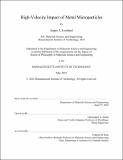High-Velocity Impact of Metal Microparticles
Author(s)
Lienhard, Jasper Z.
DownloadThesis PDF (3.434Mb)
Advisor
Schuh, Christopher A.
Terms of use
Metadata
Show full item recordAbstract
The recent development of the laser-induced particle impact test (LIPIT) has enabled direct imaging of individual microparticles as they impact a substrate at velocities of hundreds or thousands of meters per second. This technique allows for precisely controlled high-throughput impact testing, creating new opportunities for the study of material behavior under extreme dynamic conditions. In this thesis, a series of experiments are presented which use the LIPIT to impact metal microparticles onto metal substrates across a range of controlled velocities. An ultrahigh-speed camera records the resulting rapid deformation of the impacting microparticles and impacted substrates, and post-mortem characterization is conducted on each impact site. A wide range of dynamic mechanical behaviors are observed, including jetting, surface oxide break-up, impact-induced melting, particle fragmentation, and hydrodynamic penetration. This research speaks directly to the cold spray additive manufacturing method, in which a stream of solid metal particles is impacted onto a surface to deposit metal coatings. The physics that control the upper and lower bounds of the velocity window over which cold spray can occur are explored. Microparticle impact behavior regimes are measured and mapped as a function of velocity for several different metals, and the role of surface passivation layers in controlling cold spray adhesion is examined. Finally, experiments relevant to the study of impact-induced erosion are presented, which explore the formation of solid and liquid ejecta clouds during impact and examine how kinetic energy is dissipated by melting and substrate material ejection.
Date issued
2022-05Department
Massachusetts Institute of Technology. Department of Materials Science and EngineeringPublisher
Massachusetts Institute of Technology